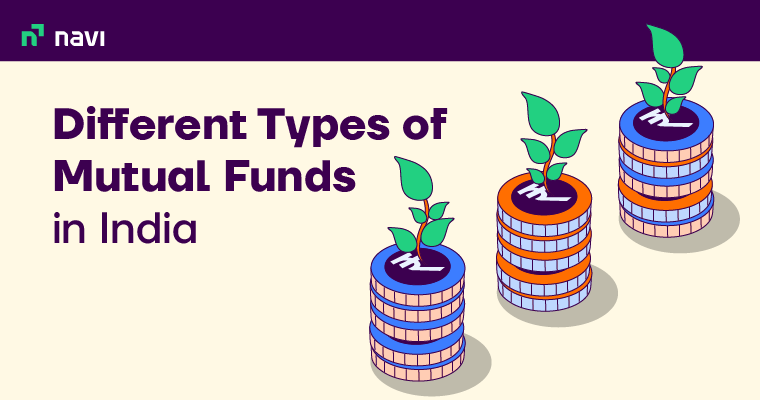Different Types of Mutual Funds in India Based on Asset Class, Risk, Structure and Market Cap

Before investing in a mutual fund scheme, it’s important to understand the objective of the scheme and whether it’s well aligned with your investment goals. To ensure you make an informed investment decision, we have curated a list of different types of mutual funds in India based on various parameters, including market cap, asset allocation, structure and risk, among others. Let’s dive in.
What are the Different Types of Mutual Funds in India?
Every mutual fund scheme belongs to a particular category based on asset allocation, market cap, investment objective, mode of investment, etc. Mutual fund schemes can be broadly classified into the following
- Based on the Underlying Portfolio: Equity, debt, hybrid, multi-asset and money market funds
- Based on Investment Objective: Tax-saving, pension, growth, income, fixed maturity, capital protection funds, etc.
- Based on Structure: Open-ended, close-ended and interval funds
- Based on Management of Portfolio: Active and passively-managed funds
- Based on Market Cap: Large-cap, mid-cap and, multi-cap and small-cap funds
Types of Mutual Funds Based on Asset Class
Mutual funds can be categorised as follows based on their underlying assets:
1. Equity Mutual Funds
An equity fund is a type of mutual fund that invests mainly in stocks and shares of companies. As per the guidelines put forward by the market regulator Securities and Exchange Board of India (SEBI), an equity mutual fund needs to invest a minimum of 65% of its total assets in equities or equity-linked instruments. These funds can be further categorised into large-cap, mid-cap, small-cap, multi-cap funds, etc. Other sub-categories include focused funds and Equity Linked Savings Schemes (ELSS).
2. Debt Mutual Funds
Debt mutual funds are mutual funds that predominantly invest in fixed-income instruments such as government securities, corporate bonds, treasury bills and money market instruments. Debt funds offer a fixed rate of interest, which in turn ensure stability and predictable returns. These funds can be further categorised based on their duration. Examples would include overnight funds, liquid funds, gilt funds, credit risk funds, etc.
3. Hybrid Funds
Hybrid funds invest in both equity and debt instruments. These funds aim to give investors a balanced portfolio through diversification. They can be further sub-categorised into balanced funds, aggressive funds, multi-asset allocation funds, etc. .
Types of Mutual Funds Based on Investment Objectives
Given below are the different types of mutual funds based on investment objectives:
1. Tax-Saving Funds
Equity-Linked Savings Schemes are known as tax-saving mutual funds as investing in these funds allows you to claim up to Rs.1.5 lakh under Section 80C of the Income Tax Act. ELSS primarily invests in equity markets and has a lock-in period of 3 years.
2. Pension Funds
The underlying concept of pension funds is to provide regular returns after a prolonged investment period. Generally, pension funds are hybrid funds with the potential to provide regular and stable returns in the future.
3. Growth Funds
Growth-based mutual funds generally invest in undervalued stocks of companies with strong fundamentals. Capital appreciation is the main aim of these funds and these schemes are ideal for people who wish to gain high returns over a long investment period.
4. Income Funds
Income mutual funds are usually debt funds that primarily invest in money market instruments, government bonds and other debt securities. The investment portfolio of these funds is based on interest rate movements of the underlying assets and their creditworthiness. In other words, income funds lend more priority to assets with higher interest rates.
5. Liquid Funds
Liquid funds are open-ended debt mutual funds that primarily invest in debt and money market instruments like government securities, commercial paper, etc. with a maturity period of up to 91 days
6. Fixed Maturity Funds
Fixed-maturity funds (FMF) invest in debt instruments that share the same maturity period as the mutual fund. For example, an FMF with a maturity period of 3 years will invest in underlying securities with a maturity period of 3 years only.
7. Capital Protection Funds
Capital protection funds aim to protect the interests of investors by preserving their capital during economic recessions. These are close-ended hybrid schemes which invest in top-rated fixed-income instruments and equities.
Also Read
Types of Mutual Funds Based on Structure
Below mentioned are the different types of mutual funds based on the structure of schemes:
1. Open-ended Funds
These mutual funds do not have any restrictions with regard to how many of their units investors can purchase. Moreover, investors can enter and exit these schemes any time of the year based on the current Net Asset Value (NAV) of the units. If liquidity is your priority, you can consider investing in open-ended mutual funds.
2. Close-ended Funds
Close-ended mutual funds have a fixed maturity period and investors can subscribe to these schemes only during the new fund offer (NFO) period. Moreover, investment units can be redeemed only after the end of the maturity period. These close-ended schemes are listed on stock exchanges after the NFO and you can purchase or sell units on the stock exchange. Often, certain close-ended mutual funds convert to open-ended schemes after the lock-in period, but fund managers cannot do so without the consent of investors.
3. Interval Funds
These mutual funds combine the provisions of both open-ended and close-ended mutual funds and enable people to engage in transactions at specific periods. So, if you invest in interval mutual funds, you can buy or redeem investment units once the trading window opens up.
Types of Mutual Funds Based on Risk
Detailed below are the types of mutual funds based on risk:
1. High-Risk Funds
High-risk funds are mutual fund schemes that are prone to market volatility but have the potential to offer high returns on investment. Equity and equity-linked funds, especially the ones that invest in companies with small market caps are considered as high-risk mutual funds. Generally, high-risk mutual funds hold the potential to generate a maximum of 20% annualised returns.
2. Medium-Risk Funds
Medium-risk mutual funds are associated with a medium/moderate level of risk because their investment portfolios contain debt instruments along with equities. It has been seen that these schemes generate average returns ranging from 9% to 12%.
3. Low-Risk Funds
Low-risk funds are usually debt funds that carry nominal risk and provide stable returns in the future. These funds generally invest in government bonds and securities, and real estate. Such funds are ideal for risk averse investors or investors looking to diversify their portfolio as a way to mitigate risk.
Types of Mutual Funds Based on Portfolio Management
Mutual funds are also classified based on their portfolio management.
1. Active Funds
Active funds are funds that are actively managed by fund managers. Fund managers use their knowledge and experience and take the help of analytical research to choose the assets to buy/sell/hold. For active funds, the aim is to design the investment portfolio in such a way so as to generate optimum returns and surpass the underlying benchmark.
2. Passive Funds
Passive funds simply mirror or track an underlying index instead of trying to outperform it. Here, fund managers play a passive role, meaning, they do not have to use their judgement or discretion to choose underlying assets. Index funds are probably the most common type of passive fund.
Types of Mutual Funds Based on Market Capitalisation
Equity mutual funds can be further classified based on market cap.
1. Large Cap Mutual Funds
Large cap funds are mutual funds that invest a large portion of their corpus in shares of companies with large market capitalisation. These companies usually have an excellent reputation in the market. Large cap funds are comparatively less-riskier than mid- and small-cap funds.
2. Mid Cap Funds
Mid cap funds are equity funds that invest a large portion of their corpus in equity shares of mid-cap companies. As per SEBI (Securities and Exchange Board of India), mid-cap companies are the ones that are ranked between 101 and 250 among listed companies.
3. Small Cap Funds
Small cap funds are equity funds that invest a large portion of their corpus in equity shares of small-cap companies. Small cap funds carry an extremely high-degree of risk, however, they have the potential to generate higher returns than large-cap and mid-cap funds.
Final Word
Invest in funds that are well-aligned with your investment goals. So, always evaluate the different types of mutual funds and their objectives before investing. However, to understand the true potential of a mutual fund, stay invested in the scheme for more than 3 years, unless you have a short-term goal.
FAQs
Ans: Yes, based on the holding period, capital gains of mutual funds are subject to certain taxes. For holding periods of over 12 months, long-term capital gains (LTCG) taxes apply; otherwise, short-term capital gains taxes are applicable.
Ans: Anyone can invest in mutual funds provided they have completed the application procedure, including the KYC verification successfully. However, most fund houses do not accept investments from NRIs living in the United States of America.
Ans: Any mutual fund’s performance is directly linked to the market. Though equity mutual funds have the highest potential to provide market-beating returns the returns are not guaranteed. Similarly, debt funds have a lower-degree of risk involved, however, they offer lower returns compared to equity funds. So, to generate best returns at minimal risk, diversify your portfolio and invest in funds that are aligned to your goals.
Ans: There is no upper limit as such regarding mutual fund investments. You can invest as much as you can via SIPs or lump sum. However, if you are just starting out, don’t go overboard with your investments. Start an SIP with a nominal amount and gradually increase the amount based on your investment goals.
Ans: The answer to this would depend on your investment objective and risk appetite. A mutual fund that yields high returns in the long term will not be suitable for an investor looking to invest for a short tenure. The best part about mutual funds as an investment option is that it offers a solution for all kinds of financial goals and risk profiles.
Ans: There are various ways to invest in mutual funds. For instance, you can invest online by visiting the official website of an AMC. You can also consider investing through a financial intermediary such as a mutual fund distributor registered with AMFI (Association of Mutual Funds in India). Investors can invest in mutual funds via SIP or lump sum. SIP or systematic investment plan entails investors to invest a fixed amount on a monthly or quarterly basis. SIP is ideal for those who are just starting out on their investment journey.
Want to put your savings into action and kick-start your investment journey 💸 But don’t have time to do research? Invest now with Navi Nifty 50 Index Fund, sit back, and earn from the top 50 companies.
Disclaimer: Mutual Fund investments are subject to market risks, read all scheme-related documents carefully.
This article has been prepared on the basis of internal data, publicly available information and other sources believed to be reliable. The information contained in this article is for general purposes only and not a complete disclosure of every material fact. It should not be construed as investment advice to any party. The article does not warrant the completeness or accuracy of the information and disclaims all liabilities, losses and damages arising out of the use of this information. Readers shall be fully liable/responsible for any decision taken on the basis of this article.

10 Best Demat Accounts in India for Beginners in 2023
Creation of Demat accounts revolutionised the way trades were conducted at the stock exchanges. It... Read More »10 Best SIP Plans for 1000 Per Month in India 2023
Systematic Investment Plan (SIP) is an investment style or route with which you can invest a fixed ... Read More »How to Invest in Mutual Funds in India – Easy Steps
Mutual funds can be an excellent way to diversify your portfolio and gain exposure to a wide range ... Read More »20 Best Nifty 50 Index Funds in India to Invest in April 2023
What is the Nifty 50 Index Fund? Nifty 50 index funds are a type of passively-managed equi... Read More »Asset Management Company (AMC) – Types and Benefits
What is an Asset Management Company (AMC)? Asset Management Company or AMC is a financial ... Read More »10 Best Gold Mutual Funds to Invest in India (April 2023)
Gold Mutual Funds are funds that invest in gold and gold-related assets such as bullion, coin... Read More »20 Best Flexi Cap Mutual Funds to Invest in India 2023
Flexi-cap funds are mutual fund schemes that aim to invest in stocks of companies across market cap... Read More »Best SIP Plans for 15 years – Top 10 SIP Plans to Invest in India 2023
A systematic investment plan (SIP) could be a convenient mode or style of investing in mutual funds... Read More »10 Best SIP Plans for 1 year Investment in India 2023
There has been a massive surge in SIP or Systematic Investment Plan investors in recent years. As p... Read More »10 Best SIP Plan for 3 Years in India to Invest in 2023
SIP or Systematic Investment Plan helps bring investment discipline in an investor’s life. It’s... Read More »10 Best SIP Plan for 10 years India in 2023 – Returns and Performance
Ask any beginner mutual fund investor and most of them would tell you that their preferred mode of ... Read More »10 Best SIP Plans for 5 years in India to Invest in 2023
Systematic Investment Plan (SIP) could be an effective investment mode if you want to invest a fixe... Read More »Top 10 Chit Fund Schemes in India in 2023
Chit funds are one of the most popular return-generating saving schemes in India. It is a financial... Read More »10 Best Gold ETFs in India to Invest in April 2023
Gold ETFs or Gold Exchange Traded Funds are passively managed funds that track the price of physica... Read More »10 Best Demat Accounts in India for Beginners in 2023
Creation of Demat accounts revolutionised the way trades were conducted at the stock exchanges. It... Read More »20 Best Index Funds to Invest in India in April 2023
What is an Index Fund? An index fund is a type of mutual fund or exchange-traded fund (ETF) that... Read More »Best Arbitrage Mutual Funds to Invest in India in April 2023
Arbitrage funds are hybrid mutual fund schemes that aim to make low-risk profits by buying and sell... Read More »10 Best SIP Plans in India to Invest in April 2023
What is SIP? SIP or Systematic Investment Plan is a method of investing a fixed amount in ... Read More »10 Best Corporate Bond Funds in India to Invest in April 2023
Corporate bond funds are debt funds that invest at least 80% of the investment corpus in companies ... Read More »10 Best Bank for Savings Account in India [Highest Interest Rate 2023]
Savings account is a type of financial instrument offered by several banks. It lets you safely depo... Read More »































